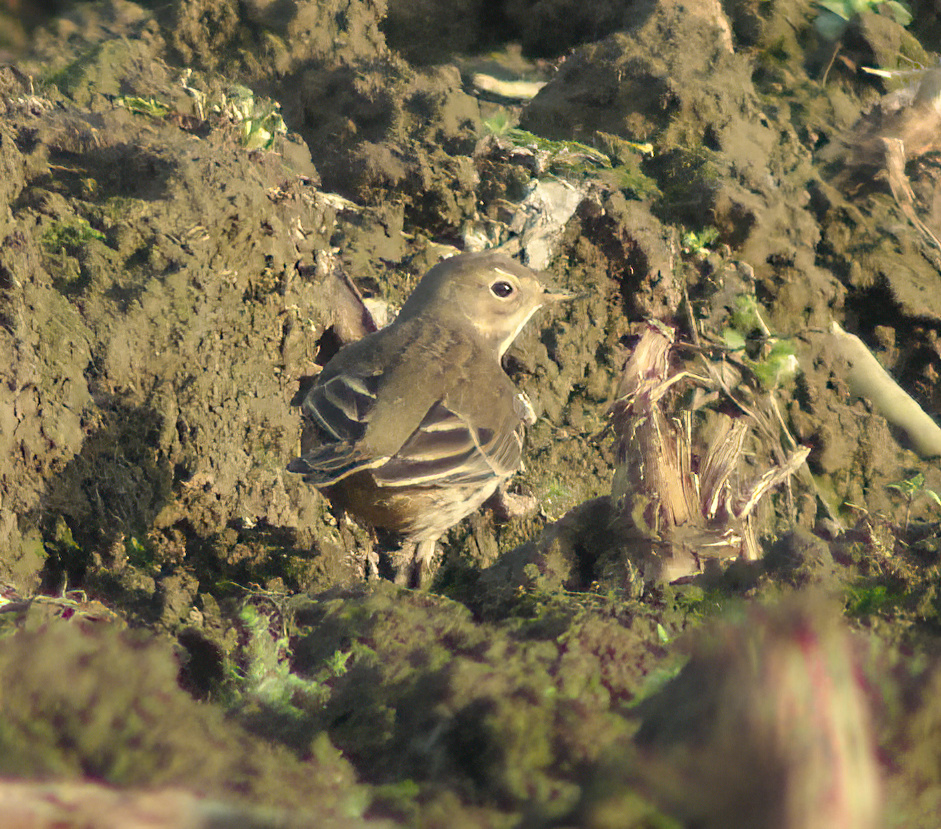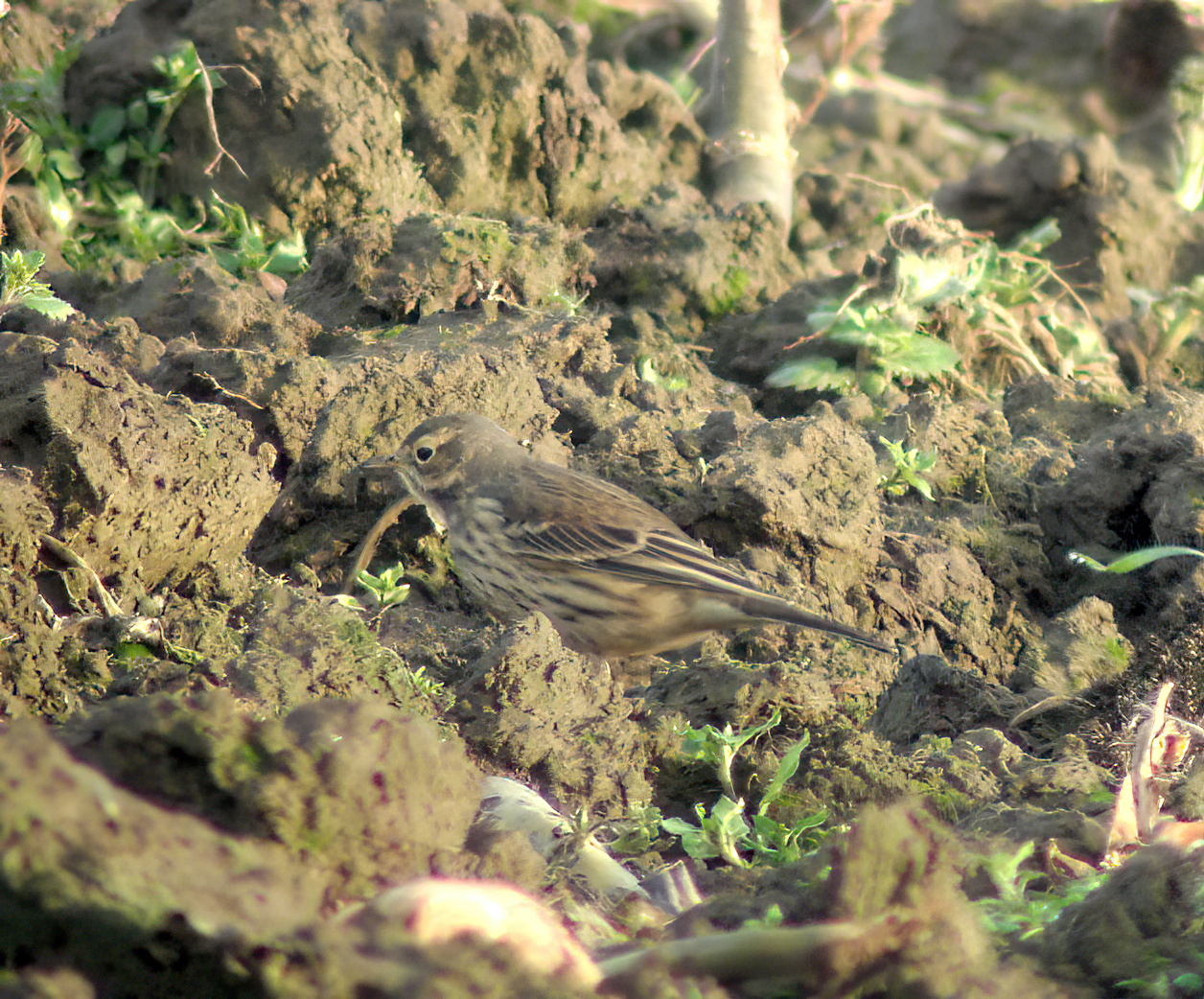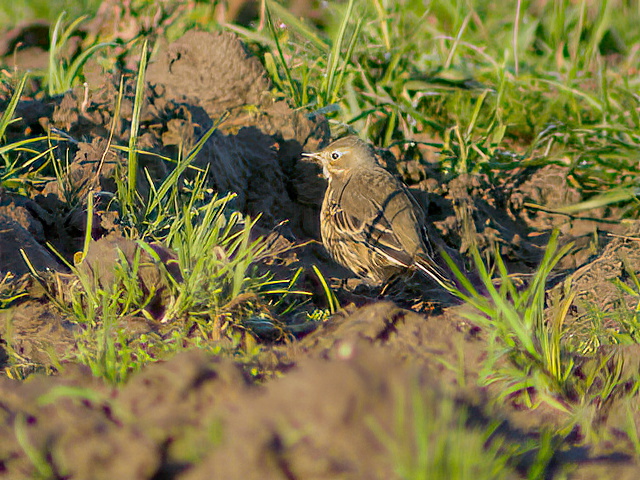Buff-bellied Pipit Anthus rubescens



Buff-bellied Pipit at Wyberton Marsh, December 2005 (Paul French).
One county record, on ploughed fields at Wyberton Marsh on Dec 5th, 2005, and then later on wet grassland at the adjacent Frampton Marsh remaining until Jan 29th, 2006. It was found associating with a large flock of Meadow Pipits A. pratensis which also included a few Water Pipits A. spinoletta and Rock Pipits A. petrosus littoralis. Initially quite elusive as the flock moved, it often disappeared down runnels in the plough. It was found and seen well during the next two days but there were some tense moments before the landowner agreed access for other birders. The news was finally put out at lunchtime on Dec 13th and some birders saw it late afternoon that day before it disappeared for the rest of 2005. It was re-found by the original finder more than a month later on Jan 24th, 2006 along a dyke on the wet grassland at Frampton, undoubtedly the last place anyone would want a rare Pipit to frequent! It then disappeared again only to be re-found in the original field where it appeared erratically until the last sighting on Jan 29th.
Buff-bellied Pipits are not easy birds to identify with certainty and this was only the third British record at the time and an exceptional find by the observers concerned and a very significant county record. Since then, more has been learned about their distinguishing characteristics with the result that there have been another 34 found between 2007-12 but with only 5 subsequently. All have been of the nominate race to date, who will find the first A.r. japonicus, the Siberian race?
| Site | First date | Last date | Count | Notes |
| Wyberton marsh | 05/12/12005 | 13/12/2005 | 1 | 1CY |
| Frampton and Wyberton marshes | 24/01/2006 | 29/01/2006 | 1 | Same as 2005 bird, now a 2CY |
Buff-bellied Pipit Anthus rubescens, Wyberton and Frampton Marshes, December 5th, 2005- January 29th, 2006, first county and UK mainland record.
by Paul French
Note: this article first appeared in the Lincolnshire Rare & Scarce Bird Report 2003-2007. The BBRC report for 2005 noted that this was only the fifth record of Buff-bellied Pipit for Britain. All four previous records have been on islands, with one on St Kilda, Western Isles, one on Fair Isle, Shetland, and two on Scilly.
Circumstances and description
On December 5th, after a hard morning in the office, John Badley and I decided to chase up a report of three Bean Geese on the fields adjacent to RSPB Frampton Marsh. As we drove down the track between the reserve and the adjacent organic farm on Wyberton Marsh, I noticed a mixed flock of pipits and wagtails in a harvested brassica field. We stopped the car and began scanning through the flock and soon found three or four Water Pipits and a few littoralis Rock Pipits among the many Meadow Pipits and Pied Wagtails. Feeling quite pleased with the Water Pipits, we were preparing to continue our goose hunt when I noticed a plain mantled and “buff-bellied” pipit in the flock. Apparently, my words were something like “Ah, that’s interesting, that looks like a Buff-bellied Pipit. My initial views lasted only about 20 seconds before the flock flew and dispersed. The obvious doubts set in - how can you even think of claiming a first for the mainland Britain on brief views in a muddy field in Lincolnshire? I must have made a mistake.
After a rather sleepless night, I took the following morning off work and went back to the site. Despite the constant drizzle and a penetrating cold, I found the bird after a couple of hours and had prolonged but rather distant views. Now I really started to panic as it still looked good for a Buff-bellied Pipit. I watched it for several minutes before the pipit flock moved on again, and I was reasonably happy that I had not been mistaken, although the topography of the field was such that individual birds were very hard to get good views of in the furrows. I thought that I had seen most of the features at some point but decided to ring Paul Harvey for some advice. I vaguely recalled a story about a pipit in Cornwall a yar or so previously that was mooted as being a Buff-bellied but could not remember any details. Paul’s words were surprisingly encouraging, but I needed better views and preferably photographs. The niggling doubts over whether it whether it really did have pale lores and a complete pale eye-ring began to gnaw, and I was well aware of the difficulties in confirming ‘negative features, but the worsening weather, my empty stomach, and the fact that I had to get back to work put paid to ant further identification attempt that day.
I returned the following morning with a borrowed Coolpix in hand and again managed to re-find the bird. The very fact that I could re-find it so easily was encouraging. Eventually, I achieved excellent and prolonged views and managed to take some record photographs. I was now finally happy that it indeed have pale lores and a complete eye-ring. The underparts were buff with extensive streaking and the upperparts were plain olive brown, with contrastingly black tertials and tail. Rather worryingly, I also confirmed that it had a distinctly grey nape. I had already spent hours poring over ‘Pipits and Wagtails’ (Alstrom et al 2003), and distinctly remembered reading that the nape of Buff-bellied Pipit was concolourous with the rest of the upperparts, while from experience and the literature I knew that Water Pipits often showed a grey nape. However, I had also spent hours looking on the internet and found several photographs of Buff-bellied Pipits that seemed to show this grey nape. I was now finally happy with the identification but sent my photographs to Paul Harvey and Adam Rowlands on BBRC for some further input, and also to Per Alstrom, author of ‘Pipits and Wagtails. The pictures were circulated around the rarities committee members, a few of whom, while stopping short of saying that it was one (the underparts are mostly obscured in my photographs), had very encouraging comments about it.
I desperately wanted to put the news out, and we approached the landowner, but sadly he denied us permission. Faced with the prospect of suppression of a mega that no-one could see, I wanted an observer with more experience to see the bird. Martin Garner visited the site on December 12th, just as we received the good news that the landowner had reconsidered and would now let us put the news out as long as we policed the resulting twitch. As I was sitting in the office about to put the news out, I checked my e-mail to discover a short but sweet message form Per Alstrom saying simply “I fully agree with your identification”. I think it was at this point that I finally felt vindicated and all the hours I’d put in staring at a muddy field had paid off. The news was broadcast mid-morning that day and a few local birders managed to connect with it before it disappeared around midday. Some contradictory messages then appeared on the bird information services, namely that eastern Water Pipit was perhaps not ruled out, as the race blakistoni shows pale lores and a complete eye-ring. However, this was soon rectified and early the next morning I hurried to the field to find a large crowd of waiting birders. It took me about an hour to find it and then point it out, and importantly it was heard to call by at least three of us. It then proceeded to show well on and off until midday when it went missing again. It then put in a final appearance later that afternoon but unfortunately could not be found the following day or subsequently that year.
It seemed that our thoughts of it successfully over-wintering had been premature until I re-found it along one of the main dykes on the wet grassland of Frampton Marsh on January 24th, 2006. It showed well, for a couple of minutes but then flew off high to the north, disappearing from view as it descended over the Haven. Could this be where it had been hiding for the past six weeks? Subsequent careful searching of the original field managed to turn up trumps when it was re-discovered there and put in highly erratic appearances here until it’s final showing on January 29th. Oh, and those Bean Geese, well, they turned out to be Pink-footed Geese, but I’ve never been so thankful for a misidentification!
Addendum
The BBRC report for 2005 pointed out some of the salient features of this bird which allowed it to be aged as a 1CY bird. The clearly defined greater coverts with extensive dark centres had pointed tips and rather narrow pale fringes which appear to be at the more obvious end of retained juvenile feathers. The greater coverts in adult birds tend to have more diffuse, squared-off dark centres and fringes which are richer buff, and also broader, especially at the tips. The possibility of this individual being of the Asian subspecies A. r. japonicus was also considered. In winter plumage, japonicus typically looks quite different in a number of ways from rubescens. There can be overlap in some characters, particularly in those birds which undergo a partial pre-breeding moult early in the New Year when the plumage of these two races becomes progressively more similar. Subtle features such as the browner underparts streaking, duller and buffer fringes to coverts and dark legs all indicated that the Lincolnshire bird was of the rubescens race.
References
Fraser, P.A., Rogers, M. J. and the Rarities Committee (2007) Report on rare birds in Great Britain in 2005: Passerines. British Birds 100: 74-104.
French, P. (undated) Buff-bellied Pipit Anthus rubescens, Wyberton and Frampton Marshes, Dec 5th 2005 - Jan 29th 2006. Lincolnshire Rare & Scarce Bird Report 2003-2007, 158-159.
(Account prepared December 2017; includes records to 2016)

